Wildlife in Your Backyard
Live in harmony with your backyard! Turtles – Wildlife
Turtles – Wildlife
Birds aren’t the only ones that can use your yard to their benefit.
Anything from Deer to tiny Tree Frogs can inhabit your yard to and use its resources. Here are some of the general wildlife you can see in your yard.
Common Musk Turtle
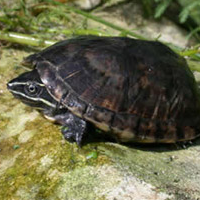
Photo: J.D. Willson
Description
Common musk turtles are small turtles (2 – 5 in; 5-12 cm) with dark brown or black shells that may be streaked or mottled and commonly accumulates green algae. There are two distinct stripes on the head and barbels on both the chin and throat.
Habitat
Musk Turtles are primarily nocturnal, and they are often seen foraging in shallow water in the evening. They are omnivorous (e.g., seeds, insects, snails, tadpoles, algae) and will occasionally scavenge on fish carrion. This species rarely emerges to bask and is most successfully captured with nocturnal trapping techniques. Musk turtles climb surprisingly well and occasionally rest fairly high in trees. Breeding occurs in the spring and fall. Mating often occurs in the water and males bite the female to see if she is receptive before mounting. Females often lay two clutches a season of 1-9 eggs under debris in loamy soils. Clutch size varies with carapace length and age, but environmental factors could be the primary influence. There is geographical variation with time of reproduction and clutch size. Nesting aggregations are occasionally observed. Male-biased sex ratios are observed consistently across populations. This species over-winters in the debris and mud under water. The name “stinkpot” is appropriately assigned due to phenolalkalinic acid excreted from glands that create a pungent musky odor. Females reach sexual maturity at 8-9.5 cm (~ 4 yrs) and males at 6-7 cm (~ 2 yrs).
For more information visit: https://srelherp.uga.edu/turtles/steodo.htm
Common Snapping Turtle
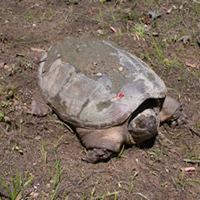
Photo: J.D. Willson
Description
The common snapping turtle is a large turtle, ranging in size from 8 to 14 in (20-36 cm) with a record length of 19.3 in (49 cm). Their average weights range from 10 to 35 lbs (4.5 – 16 kg), with a record of 75 lbs (34 kg). Their color varies from tan to dark brown to almost black in some specimens. Common snapping turtles have long tails and necks and rough shells with three rows of carapace keels.
Habitat
Snapping turtles are highly aquatic and are seldom observed basking. At times, however, they may move long distances over land and many die attempting to cross roads. Although generally docile in water, common snapping turtles will strike viciously if captured or cornered out of water. They mate April – November and typically deposit 20 – 40 eggs in concave nests dug by the female. Common snapping turtles are omnivores, taking a wide variety of vertebrate and invertebrate prey, as well as aquatic vegetation.
For more information visit: https://srelherp.uga.edu/turtles/cheser.htm
Eastern Box Turtle
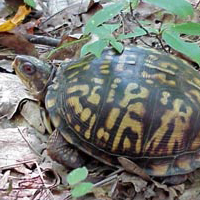
Photo: J.D. Willson
Description
Box Turtles are mid-sized, terrestrial turtles – 4.5-6 in (11.5-15.2 cm) – with a high, rounded shell that is dark with many yellow or orange splotches. The carapace pattern is variable and becomes less prominent with age. There are four toes on each hind foot. Males have a concave plastron and often have red eyes. The plastron (bottom of the shell) is hinged, allowing the box turtle to completely close it shell.
Habitat
With the exception of the Gopher Tortoise (Gopherus polyphemus), this is the most terrestrial turtle in our region. They are most commonly encountered after summer rain storms and in the fall when males actively search out females. Box turtles are omnivorous and eat mushrooms, berries, grapes, persimmons, and other fruits. Although adults are mainly herbivorous, few will turn down a juicy worm, slug, or insect. Box turtles have a low metabolic rate, which allows them to survive during times when food is scarce.
For more information visit: https://srelherp.uga.edu/turtles/tercar.htm
Eastern Mud Turtle
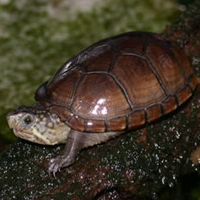
Photo: J.D. Willson
Description
The eastern mud turtle is similar in appearance to the striped mud turtle, except it lacks any prominent striping on its head. The eastern mud turtle appears to have more general habitat requirements than the striped mud turtle, although the two species may occur in the same habitat. Female eastern mud turtles may nest two or three times a year during the spring and summer, often spending several days on land during each nesting event. Although hatchlings will emerge from their eggs in late summer, they remain buried underground until the following spring. Most adults also bury themselves on land in the fall and return to a wetland in the spring. Eastern mud turtles are ubiquitous in the Southeast being found in most still-water habitats.
For more information visit: https://srelherp.uga.edu/turtles/kinsub.htm
River Cooter
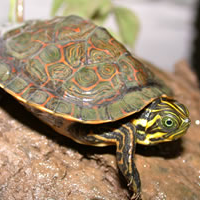
Photo: J.D. Willson
Description
The river cooter is a fairly large turtle (up to 12 inches) often observed basking on rocks and logs along the banks or in rivers. The olive or brown carapace is slightly flared posteriorly and often highlighted with lighter markings. On the river cooter, a light, backward-facing C-shaped mark on the second scute on each side of the carapace can be used to distinguish it from the Florida cooter turtle. The underside of some marginals is marked by doughnut-shaped dark spots with light centers. The plastron and bridge have dark markings, particularly along the seams between scutes. The head and neck have numerous yellow “hairpin” stripes. The postorbital stripe is not as broad as in the slider turtle, with which it might be confused. Males have straight, elongated foreclaws. Female river cooters lay about 20 eggs in May to June. This species is predominantly herbivorous.
For more information visit: https://srelherp.uga.edu/turtles/psecon.htm
Slider Turtle
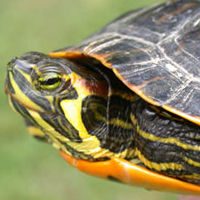
Photo: J.D. Willson
Description
The slider turtle is one of the most ubiquitous and conspicuous species of turtle in the Southeast. It occurs in every type of wetland and is frequently observed basking. Individuals are also commonly encountered on land when moving between aquatic habitats. The carapace is olive to dark brown, slightly keeled, and lightly patterned in some individuals. The plastron and the underside of the marginals are typically marked with two or more large, solid black dots or blotches. Males have elongated foreclaws and long, thickened tails. Some males may also become very dark with age. The yellow stripe behind the eye is broadest directly behind the eye. Nesting females are frequently seen from May through July.
For more information visit: https://srelherp.uga.edu/turtles/trascr.htm
Spiny Softshell
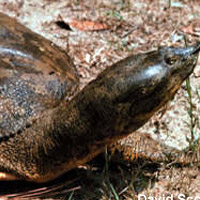
Photo: J.D. Willson
Description
Apalone spinifera are easily distinguished from other turtles because of their different looking carapace. Unlike most turtles in Georgia, the spiny softshell turtle has a flat, leathery shell with very flexible edges, “resembling a pancake.” This carapace can get up to 18″ long in females and only 9″ long in males being an olive, brown to grayish color with dark spots in males and younger turtles. In adult males, the shell has a lot of spines on the carapace, but in females, it only has a few spines.
Habitat
Softshells often bury themselves in the mud or sand where they sleep or wait for food to carelessly swim by. They can sometimes be observed basking on sandbars or logs protruding from the water. These turtles are mainly carnivorous, eating almost anything living in the water that will fit into its mouth. This includes fish, insects, and crayfish. They bury themselves in the sand or mud with only their head sticking out and grab prey as they swim by. Spiny softshell turtles are most active April through October. They usually breed in May and lay 4 to 30 eggs on sunny sandbars or in loose soil.
For more information visit: https://srelherp.uga.edu/turtles/apaspi.htm

